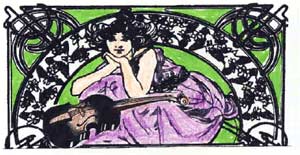|

This story was published in Radio Recall, the journal of the Metropolitan Washington Old-Time Radio Club, published six times per year.
Click here to return to the index of selected articles.
|
|
 THE HOUR OF CHARM THE HOUR OF CHARM
by Cort Vitty © 2008
(From Radio Recall, February 2008)
Newspaper columnist Ed Sullivan called them “one of the highlights of the entertainment world.” Washington Post scribe Nelson Bell commented “for variety, change of pace, and the wide scope of its musical expression, it is a model of which other orchestras, of whatever gender, might well try to emulate.” These accolades described the all-girl orchestra featured on a radio program called The Hour of Charm. Not every critic admired the group; a Chicago Tribune writer referred to the ladies as the “all-ghoul orchestra.”
Like 'em or not, The Hour of Charm was the brainchild of orchestra leader Phil Spitalny, born in Odessa, Russia on November 7,1890. His musically talented family included a violinist father and a pianist mother, who also doubled as a singer. Young Phil studied at the Conservatory of Music and toured Russia as a prodigy clarinetist.
The Spitalny family came to the United States around 1905 and settled in Cleveland. By 1925, Phil formed a group and was featured on radio station WTAM. He moved to New York in 1928, where his rather conventional all male band, the Phil Spitalny Hotel Pennsylvania Orchestra, performed concerts, played night clubs and was heard on radio.
One evening in 1932, Spitalny attended a concert featuring a young violinist named Evelyn Kaye. The bandleader was mesmerized by her talent, becoming emotionally moved as she played one extraordinary piece after another. Thinking about the performance, he began formulating plans to find other talented female musicians and organize an orchestra consisting only of women. The idea was different at the time, prompting Spitalny’s father and brothers to try and dissuade him; only his mother liked the idea and encouraged him to proceed.
Evelyn Kaye Klein was born in New York on October 19th 1917; some accounts list her birth date as far back as 1911. She won a fellowship to attend the Julliard School of Music and began appearing on radio in the 1920s. Evelyn’s magic emulated from a 1756 Berganzi, which was awarded to her by the National Arts Society.
A little detective work helped Spitalny find Evelyn’s residence, but he had a hard time getting past the front door. It seems Evelyn’s mom was not sure Mr. Spitalny’s intentions were honorable or legitimate. Divulging his plan to Evelyn’s parents, they agreed to allow their daughter to become the first member of the fledgling ensemble. She was hired as a combination musician and office worker. With all details settled, Spitalny dissolved his male orchestra and embarked with Evelyn on a countrywide search for female talent. Evelyn and her Magic Violin would become a central figure with the band and eventually one of the biggest stars on radio.
Initially, the talent search produced disappointing results. Traveling to big cities did not produce women equal to Evelyn’s level of talent. It was her idea to abandon metropolitan areas and concentrate on small towns where she reasoned “residents had little more to do than practice.”
It’s estimated Spitalny spent tens of thousands of dollars while conducting over 10,000 interviews, before 30 suitable young women were hired to join his orchestra. In later years, after the band was established, it became much easier to find talent; the Spitalny band always had first pick of the very best female musicians. At one point, Spitalny’s ensemble of musicians represented 17 states and 6 countries.
Girls agreeing to sign on were presented a contract with a long list of rules and regulations. A stylish dress code was strictly enforced; hair was to be long and flowing. The ladies were instructed to carefully watch calories, maintaining a weight of less than 120 lbs. The girls needed permission to date and were not allowed to marry. A committee was set up, headed by Evelyn, to screen potential suitors. Four or five of the women would quiz the member about her potential date’s background, education level, family history and profession. If the committee didn’t agree on the suitability of the young man, permission wasn’t granted. It was an arrangement similar to a college sorority at the time. Naturally, there were instances where girls went out with whomever they pleased; there were even rare instances when one of the girls secretly married. Generally infractions were forgiven and the girls were invited back.
One rule often broken by both Spitalny and Kaye was regarding age. The girls were supposed to be in their twenties, but it was generally acknowledged that some members performed well into their forties. Surprisingly, most ladies readily agreed to all the stipulations and signed on the dotted line. After all, it was an opportunity to perform in the big time and earn a nice depression era paycheck. Spitalny believed the rigors of travel and performance schedules were not conducive to family life.
The girls were put through a pretty tough daily regime by task master Spitalny. Right from the beginning, he felt audience acceptance had to be earned and the ladies would have to work harder than their male counterparts. His orchestra practiced from early in the morning until dinner time. The women rehearsed numbers until they memorized every note and bar; Spitalny did not allow them to read music from a stand during performances.
In the evening, the girls were expected to vigorously exercise as a way to alleviate stress and keep pounds off. Popular among band members was swimming, badminton, tennis, basketball and dancing. A weekly facial was recommended, but it was at the girls’ own expense. If time or budget didn’t permit a facial, the crew concocted their own mudpack mix of ground almond paste, which they applied and wore right up until show time. The ladies referred to this as a “facial cocktail.” Band members were encouraged to lose their winter pallor through the careful use of ultraviolet sun lamps. Time was also allotted for hairdressing and manicures.
 The ladies wore elegant white gowns while performing; Evelyn and the singers wore pastel colors. All of the members performed professionally using only their first names. A soloist was Columbus, Ohio native Maxine Moore, who won an audition and joined the orchestra. Vivien, the soprano, was actually Hollace Shaw, a native of Fresno, California and the daughter of a minister. After graduating from Pomona College, she beat out 5700 contestants by winning a west coast talent audition. Drummer Viola Smith was called the female Gene Krupa and hailed from Mt. Calvary, Wisconsin. She joined the Spitalny group in 1942, after serving in another female ensemble called The Coquettes. The ladies wore elegant white gowns while performing; Evelyn and the singers wore pastel colors. All of the members performed professionally using only their first names. A soloist was Columbus, Ohio native Maxine Moore, who won an audition and joined the orchestra. Vivien, the soprano, was actually Hollace Shaw, a native of Fresno, California and the daughter of a minister. After graduating from Pomona College, she beat out 5700 contestants by winning a west coast talent audition. Drummer Viola Smith was called the female Gene Krupa and hailed from Mt. Calvary, Wisconsin. She joined the Spitalny group in 1942, after serving in another female ensemble called The Coquettes.
The heyday of the orchestra was from 1936 to 1946 on NBC, with General Electric as the sponsor. The group started on CBS in 1934 and actually had a hard time landing that initial spot. It was tough for Spitalny to sell his group to a sponsor. Most didn’t take the all-girl ensemble seriously and dismissed the idea. Spitalny eventually found Linit as a sponsor by conducting an off premises audition; music was piped in and the sponsor liked the sound. The group was hired and only later did Linit executives find out it was an all girl orchestra. No matter – early audiences liked the show and the original 12 week contract was extended to a full season. After moving over to NBC, the group garnered high ratings for many years, performing a mix of popular music and old time classics.
Naturally, gimmicks were peppered in – such as a long whistle like sound heard at the conclusion of a couple of numbers. Listeners were curious; they wrote in by the hundreds to determine to the source of the sound. Spitalny explained it was the voice of a former Baltimore socialite named Mary Bawn. Originally a violinist with the orchestra, she injured her arm and could no longer play. Spitalny took pity and wanted to keep the 22 year old with the band. She practiced the voice trick which started like a whistle, then slowly rose up and was held for two bars. Spitalny liked it so much; it was incorporated into at least two songs a show. Young Miss Brawn was paid $250 a week for literally 45 seconds of work.
Spitalny retained his thick Russian accent and was self conscious speaking to audiences. On his radio broadcasts, he rarely stepped forward and spoke into the mike and when he did it sometimes produced disastrous results. One night the energetic bandleader said singer Maxine “took a backseat off of nobody.” Radio producers were careful to keep the microphone at a safe distance for another reason: It seems Spitalny’s frantic baton waving produced a sound that was picked up by the mike. The animated bandleader “uses his lower jaw, his neck, his shoulders, and even tosses his mane to get desired effects. He glares and he grimaces, he fumes and sweats, while the girls sweep to the left and then to the right in formation.”
During World War II, much of the music took on a patriotic flavor, as Spitalny and the girls performed benefits on both radio and before live audiences. In 1941, the ladies broadcast their regular Sunday night show from Fort Monmouth New Jersey, in front of 2,000 servicemen. During this period, it was pretty much standard for each show to open and close with a prayerful hymn. As director of an all girl orchestra during WW II, bandleader Spitalny didn’t have to worry about the draft status of his members. During the war, vocalist Vivien heard of an Army Captain who was smitten by the radio sound of her voice; the two eventually met and married. The Captain was stationed outside of Washington, D.C. and army wife Vivian commuted to New York each week in time for the broadcasts.
Spitalny and Evelyn Kaye were married outside of Atlantic City N.J. on June 17th 1946. By then, The Hour of Charm was reduced to a Sunday afternoon spot on CBS; it ultimately left the air in 1948. The Spitalny group continued to tour until he retired as orchestra leader and composer in 1955. Moving to Miami, he served as music critic for the Miami Beach Sun and the Miami Beach Reporter.
Phil passed away in Miami on October 11, 1970. When Evelyn died of heart failure in 1990, she left behind a talented sisterhood comprising the most popular all-girl orchestra in the history of radio. The orchestra was showcased in a number of Hollywood films; however their largest role was in the 1945 Abbott and Costello feature, Here Come the Co-Ed’s. One critic commented that “Phil Spitalny doesn’t look like a college professor nor does the personnel of his all-girl orchestra look like students, but they add immeasurably to the box office appeal of this film.”
Sources:
The Encyclopedia of Old-Time Radio – John Dunning
The Encyclopedia of American Radio – Luther Sies
The Chicago Tribune
The Los Angeles Times
The New York Times
The Washington Post
Tune In – July 1943
Tune In – October 1944
|